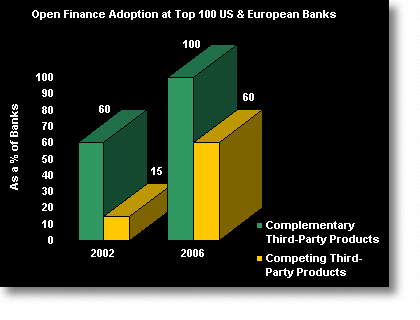Open Finance in the US and Europe: A Perfect Storm in Retail Banking
Abstract
Celent releases an in-depth analysis of Open Finance, a key issue for bank CEOs. By 2005, Celent predicts that 60% of top US and European banks will sell competitors' products. Celent sees Open Finance as ineluctable in a world of undifferentiated banks struggling to market commoditized products.
In a new report, "Open Finance in the US and Europe: A Perfect Storm in Retail Banking", Celent examines the long term drivers forcing a shift from a proprietary distribution model in retail banking towards an Open Finance model. Celent predicts that 60% of top US and European banks will offer competitors' products by 2006, up from 15% in 2002; 100% of them will offer complimentary products, up from 60% in 2002.

Celent anticipates Open Finance to take the retail banking industry by storm in the next 4-5 years. "Bankers hoping to see Open Finance vanish misjudge the drivers and the scope of the phenomenon " comments Gwenn Bézard, the author of the report. The surge of Open Finance, which involves the delivery of third party products, as well as the sale of products via non-proprietary channels, stems from fundamental changes in the banking industry, including the disruption of traditional banks’ value chains.
"With Open Finance, banks are experiencing the same forces which reshaped consumer retailing in the 60's" adds Gwenn Bézard. For decades, the banking industry has escaped the fate of the food, music, and consumer electronics industries, which are now dominated by global distributors. Because of the complexity of their products, low automation, and regulatory issues, banks have maintained a stronger integration of manufacturing and distribution. Over the past decade, however, multiple forces have encouraged banks to unbundle manufacturing and distribution, opening their delivery networks to non-proprietary products, as well as relying on third-party manufacturers for best-of-breed products. While banks are still keeping discount retailers at bay, they have begun to use their distribution networks to offer products from other financial institutions, thus creating Open Finance. "Banks are being pulled into Open Finance faster than they may realize" concludes Gwenn Bézard.

